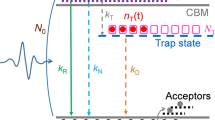Abstract
In thermally stimulated processes the calculation of the transition probability of a trapped charge carrier into an excited state is based on an atomistic model involving multiphonon processes. The displacement of lattice particles from equilibrium positions gives rise to electron-lattice interaction. As a result the temperature dependence is found to be of non-Arrhenius type except in some limiting cases. The difference of the probabilities for non-radiative transitions, as calculated by the quantum mechanical and by semi-classical methods, is discussed. Thermoluminescence proves to be an example for a non-radiative transition controlled phenomenon and the calculated glow curve differs appreciably from one model to the other. As a result the glow curves calculated in the quantum mechanical concept exhibit shapes which are broadened and shifted to lower temperatures, as compared to that calculated in the semi-classical concept. In turn, the activation energy, as determined by the initial rise method or the method of heating rate variation, is found to be much smaller in the quantum mechanical case.
Similar content being viewed by others
References
D. Curie:Luminescence in Crystals (Methuen, London; Wiley, New York 1963) pp. 143–147
G.A. Marlor: Phys. Rev.159, 540 (1967)
J.H. Gibbs: J. Chem. Phys.57, 4473 (1972)
P. Bräunlich (ed.):Thermally Stimulated Relaxation in Solids, Topics Appl. Phys.37 (Springer, Berlin, Heidelberg 1979) pp. 50–59
A. Haug: InFestkörperprobleme 12, 411–447 (Pergamon, Oxford; Vieweg, Braunschweig 1972)
A. Haug:Theoretische Festkörperphysik II (Deuticke, Wien 1970) pp. 329–350
M. Böhm, A. Scharmann: Phys. Stat. Sol. (a)5, 563 (1971)
A.M. Stoneham: Rep. Prog. Phys.44, 1251 (1981)
P. Kivits, H.J.L. Hagebeuk: J. Luminesc.15, 1 (1977)
W. Hoogenstraaten: Philips Res. Rep.13, 515 (1958)
J. Bonnafe, M. Castagne, J. Romestan, J.P. Fillard: J. Phys. C14, 2465 (1981)
D.W. Cooke, S.L. Fortner, M.S. Jahan: J. Luminesc.26, 319 (1982)
N. Riehl, P. Thoma: Z. angew. Physik14, 751 (1962)
P.D. Townsend, C.D. Clark, P.W. Levy: Phys. Rev.155, 908 (1967)
Author information
Authors and Affiliations
Rights and permissions
About this article
Cite this article
Böhm, M., Erb, O. & Scharmann, A. Quantum mechanical treatment of the escape probability from traps in thermally stimulated processes. Appl. Phys. A 37, 165–170 (1985). https://doi.org/10.1007/BF00617501
Received:
Accepted:
Issue Date:
DOI: https://doi.org/10.1007/BF00617501




